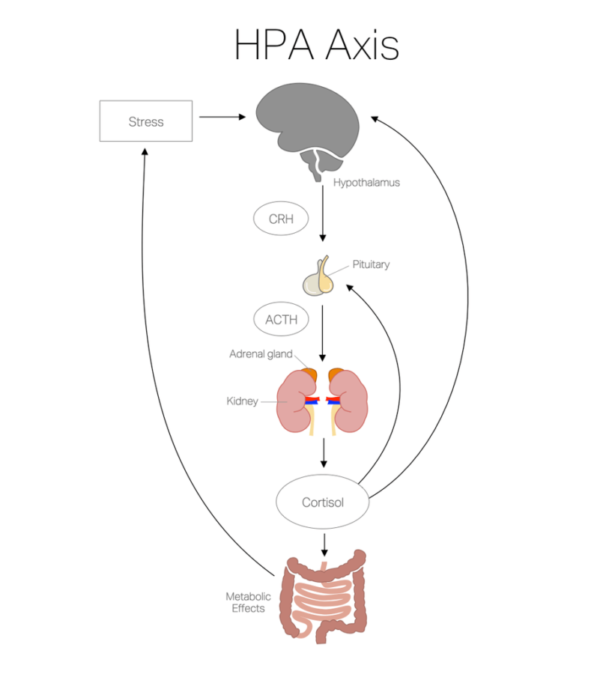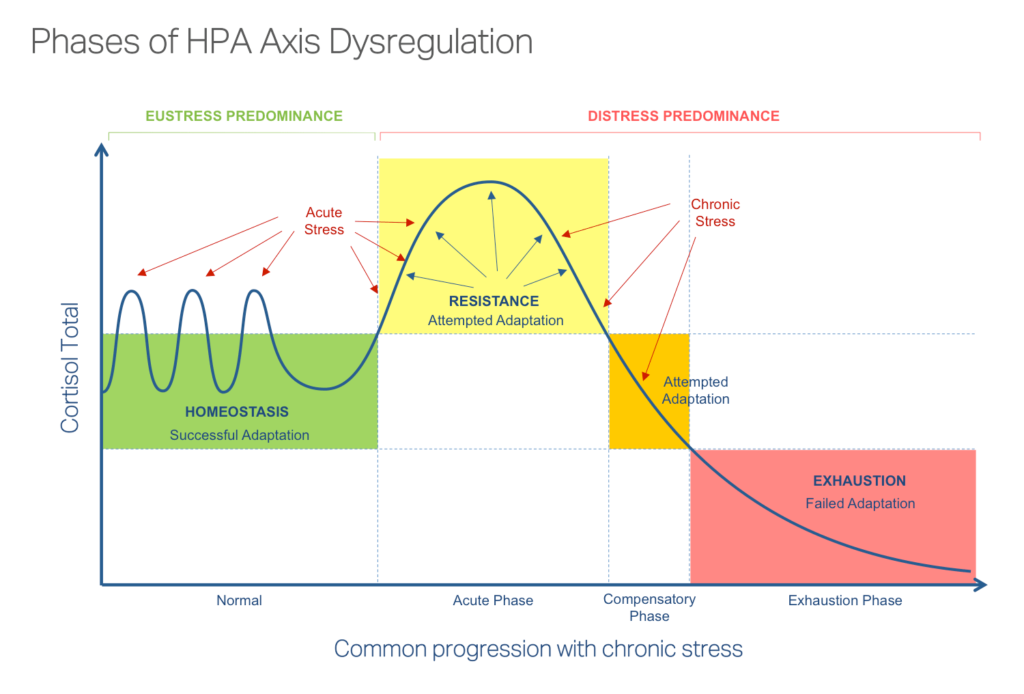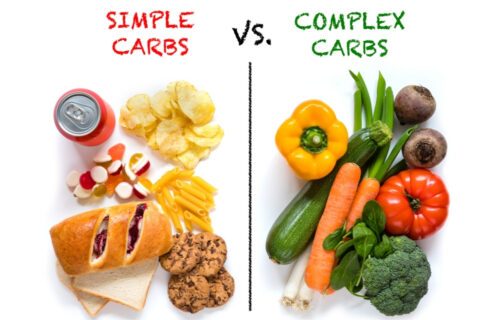
Adrenal Fatigue or HPA axis Dysregulation?
What is Adrenal Fatigue?
Is this a true definition?
Is it real?
Ok, so you are tired – REALLY tired – or EXHAUSTED?!
Does that mean you have adrenal fatigue?
There are varying degrees of tiredness, we all get that.
But when the fatigue is relentless, when you don’t get relief from a good night sleep and the fatigue starts to affect other aspects of your life it is time to look a little deeper.
We have all heard that constant stress ‘drains your adrenals,’ ‘they ‘get tired and then fatigued and run out of cortisol’. Well it isn’t as simple as that. And anyone who may have asked their GP to test them for adrenal fatigue will know the quizzical look they get in reply ‘adrenal fatigue is not real, it doesn’t exist!’
Well, I would like to shed some light on what is really happening here, and some of the points are actually as simple as getting the terminology correct. But, also to help you understand what and why.
Ok, so let’s look at what your adrenals actually are and what they do.
The adrenals are walnut sized glands that sit on your kidneys and produce hormones including cortisol, aldosterone, adrenaline, DHEA and small amounts of sex hormones like oestrogens, progesterone and testosterone. Cortisol is produced in response to any stress – be it physical, emotional and perceived.
There are many roles governed by the adrenals and the hormones produced. Cortisol has essential functions that are protective against stressors by stabilizing blood sugar, reducing inflammation, suppressing immune activation, promoting fat burning (yep – that’s right), helping regulate emotions and a balancing effect on other hormones.
STRESS – Well that is a PhD in itself. But suffice is to say – stress in inevitable, but the way we react to it is important. AND the big variable is short term stress versus chronic ongoing stress.
75 – 90% of primary care visits have been reported to be stress related.
Importantly, cortisol levels rise under stress but if stress continues without enough rest for recovery the adrenal glands become depleted and unable to produce enough. If elevated stress continues for months or years, adequate cortisol levels can no longer be maintained and start to plummet.
This has a chain-reaction impact on other hormones, organs and body systems. In short, adrenal hormone production is an indicator of overall body function and an imbalance in this system is a sign of chronic illness. It is therefore vital to address and treat any adrenal dysfunction as a priority.

So what is HPA Axis Dysfunction/Dysregulation then?
First of all HPA stands for hypothalamic-pituitary-adrenal axis.
The various parts of the HPA axis work together in an interwoven series of webs. It’s part of your endocrine system which is often compared to an orchestra – everything must work together to stay in tune. In the case of HPA axis dysfunction, it’s like a domino effect that takes off after the body becomes desensitized to stress hormones.
Hypothalamus (H) – This is a region of your forebrain that connects the autonomic nervous system and the endocrine system with the pituitary gland. It’s function is to send messages from the brain to the adrenals, the pituitary and other organs. It is important in maintaining bodily homeostasis – through regulating sleep, emotions, body temperature, hunger, thirst, and more.
Pituitary gland (P) – This pea-sized gland is found at the base of the brain. The pituitary gland is considered the master gland because it regulates other endocrine glands and hormones like growth hormone, anti-diuretic and luteinizing hormone.
Adrenal glands (A) – Your adrenal glands sit on the top of your kidneys and produce important hormones such as adrenaline and cortisol, as explained above. It is a large part of what we term ‘fight or flight’ response.
Together these three parts work to regulate your stress response, mood, motivation, metabolism, energy levels, and immune system.
How do the different parts of the HPA axis interact?
See diagram above…
We begin with the stressor. That could be a moment of imminent physical danger, or it could be simply thinking about a public speaking. Whichever it is, the reaction from your body is pretty much the same.
Next, your hypothalamus releases corticotrophin-releasing hormone (CRH), which sends a message to the pituitary. This stimulates the pituitary’s ACTH production, which then prompts your adrenals to make cortisol. Among other things, cortisol raises the sugar in your bloodstream and prepares your body for the high-energy ‘fight-or-flight’ response that it is anticipating. Your adrenals also release adrenaline, which raises your heart rate and increases your blood pressure.
These interactions continue until your hormones reach the levels that your body needs, and then a series of chemical reactions begins to switch them off.
So is it adrenal fatigue or HPA-D?
“Adrenal fatigue” is a bit of a misnomer these days. It has become a popular term to represent the effects of feeling stressed or feeling exhausted or burnt out. Sometimes it might be called “adrenal insufficiency” or “adrenal exhaustion”.
“Adrenal fatigue” is not a recognised medical condition and it is different to primary adrenal insufficiency (aka Addison’s disease). Addison’s disease is a rare condition which occurs when the adrenal cortex is damaged and fails to produce cortisol (and sometimes aldosterone) requiring medical treatment. Unlike “adrenal fatigue”, it is not stress related.
We now have a better understanding of what’s known as “physiological resilience”. That is, the capacity of a cell, tissue or organ (in this case the adrenal gland) to respond to changes in physiological need (i.e. stressors) from moment to moment. It’s our body’s ability to respond in an instant.
We also now know that each of us has a “metabolic reserve”. This is the ability of our cells, tissue or organs to withstand repeated and ongoing challenges over the long term and repeatedly revert to “normal” function.
Everyone’s physiological resilience and metabolic reserve will be different depending on their genes, diet, lifestyle and environment.
Eventually, if the challenges to your system outweigh your metabolic reserve, your system is unable to bounce back like it did leading to dysfunction. Your stress response remains high and your ability to cope with each new stressor diminishes.
The HPA axis is supposed to allocate resources and influence the production of your stress hormones (amongst others) to give you the best chance of survival in the short term (i.e. your fight or flight response). This is fine provided the short term need doesn’t persist. And therein lies the problem – constant or frequent stress results in depletion of your metabolic reserve, a loss of resilience and dysregulation of the system.
It is believed that the signs and symptoms you experience are the result of what’s happening in this bigger picture. Maybe the signals aren’t being sent in the right amount at the right time (perhaps explaining why you are wide awake at night and sleepy all day ‘wired but tired’). Or maybe they aren’t being received….a bit like when you talk to your kids, partner, cat etc and they don’t seem to hear you!?! This could be the problem with your adrenal glands …. they are capable of working but they aren’t picking up the signals.
So “adrenal fatigue” or “adrenal exhaustion” are more accurately referred to as HPA axis dysregulation

KEY POINTS
- Adrenal fatigue = HPAdysregulation
- It is a signalling problem, not a simple tired gland
- The nervous system function relies on hormone production for survival
- You have to look further upstream than just the output
- If the challenges to your system outweigh your metabolic reserve, your system is unable to bounce back and your stress response remains high and your ability to cope with each new stressor lessens.
- Problem – constant or frequent stress results in depletion of your metabolic reserve,
SIGNS AND SYMPTOMS
Common:
- Feeling unrefreshed in upon waking, even after a long sleep
- Intense fatigue
- Inability to deal with stress A declining ability to cope with everyday stress like you used to
- Increased anxiety
- Craving salty foods
- Weakened immune system
- Feeling wired / agitated, but tired
- General feeling of being ‘unwell’
- Increased dependence on caffeine or similar stimulants to get through the day
- Increased irritability or loss of joy and pleasure
- Changes in menstrual cycle or increased PMS
Other:
- Asthma, allergies or respiratory complaints
- Dark circles under the eyes
- Dizziness / light headedness
- Dry skin
- Extreme tiredness an hour after exercise
- Frequent urination
- Joint pain / body aches / low back pain
- Lines in your fingertips
- Loss of muscle tone
- Low blood pressure
- Low blood sugar
- Low sex drive
- Numbness in your fingers / Poor circulation
- Un-explained weight gain
Get in touch to hear about what to do to help yourself…



